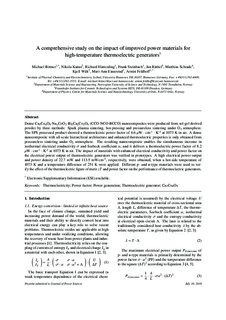| dc.contributor.author | Bittner, Michael | |
| dc.contributor.author | Kanas, Nikola | |
| dc.contributor.author | Hinterding, Richard | |
| dc.contributor.author | Steinbach, Frank | |
| dc.contributor.author | Räthel, Jan | |
| dc.contributor.author | Schrade, Mattias | |
| dc.contributor.author | Wiik, Kjell | |
| dc.contributor.author | Einarsrud, Mari-Ann | |
| dc.contributor.author | Feldhoff, Armin | |
| dc.date.accessioned | 2019-01-16T08:04:58Z | |
| dc.date.available | 2019-01-16T08:04:58Z | |
| dc.date.created | 2019-01-15T10:49:53Z | |
| dc.date.issued | 2019 | |
| dc.identifier.citation | Journal of Power Sources. 2019, 410 143-151. | nb_NO |
| dc.identifier.issn | 0378-7753 | |
| dc.identifier.uri | http://hdl.handle.net/11250/2580784 | |
| dc.description.abstract | Dense Ca3Co4O9-NaxCoO2-Bi2Ca2Co2O9 (CCO-NCO-BCCO) nanocomposites were produced from sol-gel derived Ca2.25Na0.3Bi0.35Tb0.1Co4O9 powder by four methods: Hot-pressing (HP), spark plasma sintering (SPS) and pressureless sintering in air or O2 atmosphere. Nanocomposites from HP and SPS revealed nanosized grains and showed a thermoelectric power factor of 4.8 and 6.6 μW cm−1 K−2, respectively, at 1073 K in air. A dense 2D nanocomposite with structures on multiple length scales and enhanced thermoelectric properties was obtained from pressureless sintering in O2 atmosphere. The resulting 2D nanocomposite enabled the simultaneous increase in isothermal electrical conductivity σ and Seebeck coefficient α, and showed a thermoelectric power factor of 8.2 μW cm−1 K−2 at 1073 K in air. The impact of materials with enhanced electrical conductivity and power factor on the electrical power output of thermoelectric generators was verified in prototypes. A high electrical power output and power density of 22.7mW and 113.5mW cm−2, respectively, were obtained, when a hot-side temperature of 1073 K and a temperature difference of 251 K were applied. Different p- and n-type materials were used to verify the effect of the thermoelectric figure-of-merit zT and power factor on the performance of thermoelectric generators. | nb_NO |
| dc.language.iso | eng | nb_NO |
| dc.publisher | Elsevier | nb_NO |
| dc.rights | Attribution-NonCommercial-NoDerivatives 4.0 Internasjonal | * |
| dc.rights.uri | http://creativecommons.org/licenses/by-nc-nd/4.0/deed.no | * |
| dc.title | A comprehensive study on improved power materials for high-temperature thermoelectric generators | nb_NO |
| dc.type | Journal article | nb_NO |
| dc.type | Peer reviewed | nb_NO |
| dc.description.version | acceptedVersion | nb_NO |
| dc.source.pagenumber | 143-151 | nb_NO |
| dc.source.volume | 410 | nb_NO |
| dc.source.journal | Journal of Power Sources | nb_NO |
| dc.identifier.doi | https://doi.org/10.1016/j.jpowsour.2018.10.076 | |
| dc.identifier.cristin | 1656910 | |
| dc.relation.project | Norges forskningsråd: 228854 | nb_NO |
| dc.description.localcode | © 2018. This is the authors’ accepted and refereed manuscript to the article. Locked until 13.11.2020 due to copyright restrictions. This manuscript version is made available under the CC-BY-NC-ND 4.0 license http://creativecommons.org/licenses/by-nc-nd/4.0/ | nb_NO |
| cristin.unitcode | 194,66,35,0 | |
| cristin.unitname | Institutt for materialteknologi | |
| cristin.ispublished | true | |
| cristin.fulltext | postprint | |
| cristin.qualitycode | 1 | |

